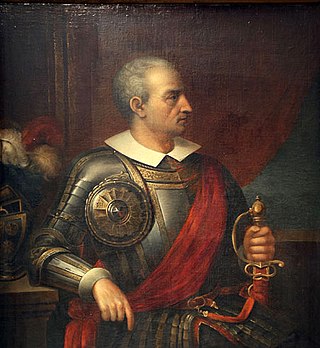
Diego de Almagro, also known as El Adelantado and El Viejo, was a Spanish conquistador known for his exploits in western South America. He participated with Francisco Pizarro in the Spanish conquest of Peru. While subduing the Inca Empire he laid the foundation for Quito and Trujillo as Spanish cities in present-day Ecuador and Peru respectively. From Peru, Almagro led the first Spanish military expedition to central Chile. Back in Peru, a longstanding conflict with Pizarro over the control of the former Inca capital of Cuzco erupted into a civil war between the two bands of conquistadores. In the battle of Las Salinas in 1538, Almagro was defeated by the Pizarro brothers and months later he was executed.
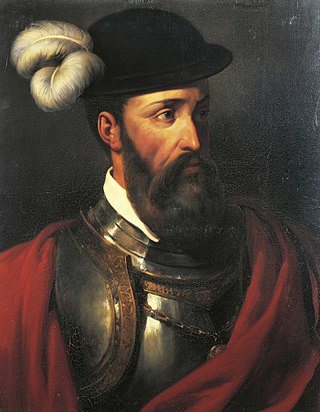
Francisco Pizarro, Marquess of the Atabillos was a Spanish conquistador, best known for his expeditions that led to the Spanish conquest of the Inca Empire.

Pedro Gutiérrez de Valdivia or Valdiva was a Spanish conquistador and the first royal governor of Chile. After serving with the Spanish army in Italy and Flanders, he was sent to South America in 1534, where he served as lieutenant under Francisco Pizarro in Peru, acting as his second in command.
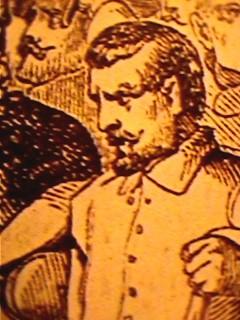
Gonzalo Pizarro y Alonso was a Spanish conquistador and younger paternal half-brother of Francisco Pizarro, the conqueror of the Inca Empire. Bastard son of Captain Gonzalo Pizarro y Rodríguez de Aguilar (senior) (1446–1522) who as colonel of infantry served in the Italian campaigns under Gonzalo Fernández de Córdoba, and in Navarre, with some distinction, and María Alonso, from Trujillo. He was the half brother of Francisco and Hernándo Pizarro and the full brother of Juan Pizarro.

Manco Inca Yupanqui was the founder and monarch of the independent Neo-Inca State in Vilcabamba, although he was originally a puppet Inca Emperor installed by the Spaniards. He was also known as "Manco II" and "Manco Cápac II". He was one of the sons of Huayna Capac and a younger brother of Huascar.

Francisco de Carvajal was a Spanish military officer, conquistador, and explorer remembered as "the demon of the Andes" due to his brutality and uncanny military skill in the Peruvian civil wars of the 16th century.

Hernando Pizarro y de Vargas was a Spanish conquistador and one of the Pizarro brothers who ruled over Peru.

Sayri Túpac was an Inca ruler in Peru. He was a son of siblings Manco Inca Yupanqui and Cura Ocllo. After the death of his mother in 1539 and of his father in 1544, both at the hands of Spanish conquerors, he became the ruler of the Neo-Inca State in Vilcabamba. He ruled until his death in 1560.

Pedro de la Gasca was a Spanish bishop, diplomat and the second (acting) viceroy of Peru, from 10 April 10 1547 to 27 January 1550.
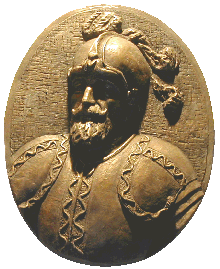
Alonso de Alvarado Montaya González de Cevallos y Miranda (1500–1556) was a Spanish conquistador and knight of the Order of Santiago.
Pedro Pizarro was a Spanish chronicler and conquistador. He took part in most events of the Spanish conquest of Peru and wrote an extensive chronicle of them under the title Relación del descubrimiento y conquista de los reinos del Perú, which he finished in 1571.

The Battle of Jaquijahuana was fought between the forces of Gonzalo Pizarro and Pedro de la Gasca, on April 9, 1548, during the Revolt of the Encomenderos by the Spanish conquistadores.
After his unheard claims as governor of New Castile (Peru) following the death of his brother, Gonzalo Pizarro pressed claims to be recognized as the ruler of the land he and his brothers had conquered. After the arrival of appointed royal viceroy Blasco Núñez Vela in 1544, Gonzalo succeeded to have him repelled and sent to Panama in chains. He was released, however, and returned to Peru by sea while Gonzalo was mustering an army. The two met on January 18 at Iñaquito in the outskirts of Quito, present-day capital of Ecuador, where the superiority of the Nueva Castilla army ensured victory for Gonzalo. Blasco Núñez Vela reportedly fought but fell as a victim in battle and was later decapitated on the field of defeat, a fate Gonzalo himself would share two years later at Jaquijahuana.
After sending away royal appointed governor of the Viceroyalty of Peru, Blasco Núñez Vela and later defeating and killing him in the battle of Añaquito, Gonzalo Pizarro assembled an army of 1,200 men to press claims for the rule over Peru, once belonging to him and his brothers. The new viceroy, Pedro de la Gasca, landed in Peru in 1547, and a contingent of his troops, led by Diego Centeno, was severely defeated at Huarina by Francisco de Carvajal

Pedro de Candia was a Greek explorer and cartographer at the service of the Kingdom of Spain, an officer of the Royal Spanish Navy that under the Spanish Crown became a Conquistador, Grandee of Spain, Commander of the Royal Spanish Fleet of the Southern Sea, Colonial Ordinance of Cusco, and then Mayor of Lima between 1534 and 1535. Specialized in the use of firearms and artillery, he was one of the earliers explorers of Panama and the Pacific coastline of Colombia, and finally participated in the conquest of Peru. He was killed in the Battle of Chupas, (Peru), on 16 September 1542, by Diego de Almagro II.
The Battle of Abancay was a battle that took place during the Spanish conquest of Peru. Alonso de Alvarado, sent by Francisco Pizarro to relieve the siege of Cusco, was camped at Jauja with five hundred men. He guarded the bridge and a ford on the Rio de Abancay, awaiting Almagro's men. However, the soldier Alvarado placed in command of the ford, Pedro de Lerma, deserted, allowing Almagro to capture Alvarado's force almost intact.

Alonso de Mendoza was a Spanish captain, conquistador, and the founder of the city of Nuestra Señora de La Paz. He was appointed by Pedro de la Gasca, the "Peacemaker," to found the city to commemorate the peace in the Peruvian colonies after the defeat of the Pizarro brothers.
Alonso de Cáceres y Retes was a Spanish conquistador and governor-captain of Santa Marta, who traveled extensively throughout the Americas from Mexico, south through Central America, and as far as Peru. He was one of the most active soldiers in the 16th-century Spanish colonization of the Americas.
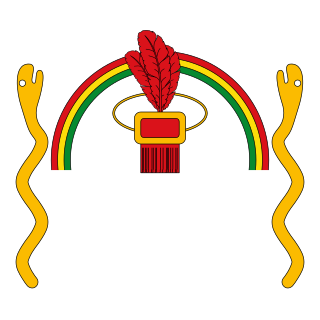
The Neo-Inca State, also known as the Neo-Inca state of Vilcabamba, was the Inca state established in 1537 at Vilcabamba by Manco Inca Yupanqui. It is considered a rump state of the Inca Empire (1438–1533), which collapsed after the Spanish conquest in the mid-1530s. The Neo-Inca State lasted until 1572, when the last Inca stronghold was conquered, and the last ruler, Túpac Amaru, was captured and executed, thus ending the political authority of the Inca state.
Gómez de Alvarado y Contreras was a Spanish conquistador and explorer. He was a member of the Alvarado family and the older brother of the famous conquistador Pedro de Alvarado.














